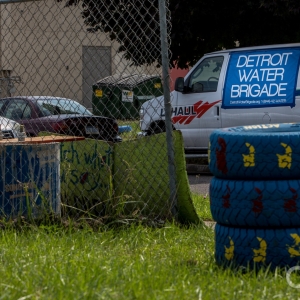The Stream, December 3, 2021: Some California Water Districts Are Told Not to Expect Requested Supplies in 2022
YOUR GLOBAL RUNDOWN
- A new study discovers the major driver of crippling drought in Madagascar.
- Canadian officials urge the federal government to spend more money on water projects in Indigenous communities.
- While residents in an impoverished village in South Africa go without running water and plumbing, its government built community centers that have gone unused.
- California’s Department of Water Resources announces water agencies will only receive water supplies critical for health and safety next year.
An all-female group of Colombian lawyers defend Indigenous communities from oil and coal development.
“With the environmental issue, to defend water is to go against million dollar contracts that have been signed between the state and companies.” – Julia Figueroa, director of the Luis Carlos Pérez Lawyers Collective Corporation (CCALCP). An all female group of lawyers in Colombia constantly face threats for defending environmental rights and protecting communities affected by armed conflict. Much of the work of the CCALCP is to protect indigenous communities from oil and coal mining, which often come at the expense of local water supplies and the surrounding environment. Figueroa told The Guardian that their work often goes against the mission of the Colombian government, which has frequently tried to portray environmental defenders as hindering economic progress.
IN RECENT WATER NEWS
Rising Cost of Water in Michigan Leads to Affordability Problems
The rising cost of water and sewer service in Michigan is consuming a larger share of household income, leading to mounting financial burdens for both families and communities, particularly those with high poverty rates, a new report finds.
The growing affordability problem spreads beyond publicized examples in Detroit and Flint, according to the assessment. Rural areas, small towns, and suburbs have also seen costs rise, though at a slower pace than their urban counterparts. As Michigan agencies prepare to spend hundreds of millions of dollars in the coming years in federal infrastructure and pandemic relief funds, the report authors say that the time was ripe for a deeper understanding of who is hurt by unaffordable water.
The report from the University of Michigan Water Center, Michigan State University Extension, and the consulting firm Safe Water Engineering fills in some of those gaps. It found a sharp rise in the number of Michigan households paying more than 5 percent of income on water and sewer services. That number, when adjusting for inflation, grew from 1.6 percent of households in 1980 to 6.7 percent in 2018.
In Case You Missed It:
Utah’s Water Dilemma – Record-breaking drought along the Wasatch Front forces tough decisions about water supply.
What’s Up With Water—November 29, 2021 – This week’s episode covers water shortages in South Africa, unprecedented flooding in South Sudan that is superseding vaccine drives, and a battle over renewable energy in New England.
Prolonged Drought in Madagascar Fueled By Environmental Degradation, Not Climate Change
A new study found that climate change isn’t driving prolonged drought in Madagascar. The East African country is in the midst of an extreme drought that has destroyed harvests and left much of the country hungry. A team of 20 scientists found that the severe drought spells are common in Madagascar, and environmental degradation has caused sandstorms and locusts outbreaks that have exacerbated the drought’s effects.
- Why It Matters: Southern Madagascar is historically dry, comprising vast desert stretches. Over the past year, this parched landscape has grown even more barren, as the country’s worst drought in over four decades has ravaged food supplies, sweeping hunger throughout the region. The drought’s human toll is enormous. Over one million people in southern Madagascar need food urgently. Residents have resorted to eating cacti and celebrating the arrivals of usually unwanted, though edible, locust swarms.
TODAY’S TOP WATER STORIES, TOLD IN NUMBERS
$138 MILLION
Canadian Parliamentary Budget Officer Yves Giroux said in a report this week that the federal government needs to increase spending in order to provide clean water in First Nations. The report found that while the government is spending enough to bring clean water to Indigenous communities by building water and wastewater systems, they will need to spend $138 million more annually to meet operational needs.
5 MILLION RAND ($313.3 THOUSAND)
Between 2016 and 2018, the local government in Zebediela, a village in the South African province of Limpopo, built two community centers for residents, each between R4 million and R5 million. Meanwhile, impoverished villagers have gone without tap water and have been forced to use pit latrines. Now, residents say the community halls have gone all-but untouched and are already deteriorating due to lack of maintenance.
ON THE RADAR
California’s Department of Water Resources announced water agencies will get zero percent of the water they requested for 2022 aside from what is necessary for critical health and safety. State officials said mandatory water restrictions will be announced and that consumers should try to conserve wherever they can. The State Water Project, which is operated by the DWR, is only one source of water for the 29 water districts it supplies; other sources include the Colorado River and local storage projects. DWR reassesses water supply conditions monthly and can increase allocations if snowpack and reservoir levels warrant it.
- In Context: Drought in California
Jane is a Communications Associate for Circle of Blue. She writes The Stream and has covered domestic and international water issues for Circle of Blue. She is a recent graduate of Grand Valley State University, where she studied Multimedia Journalism and Women, Gender and Sexuality Studies. During her time at Grand Valley, she was the host of the Community Service Learning Center podcast Be the Change. Currently based in Grand Rapids, Michigan, Jane enjoys listening to music, reading and spending time outdoors.






Leave a Reply
Want to join the discussion?Feel free to contribute!